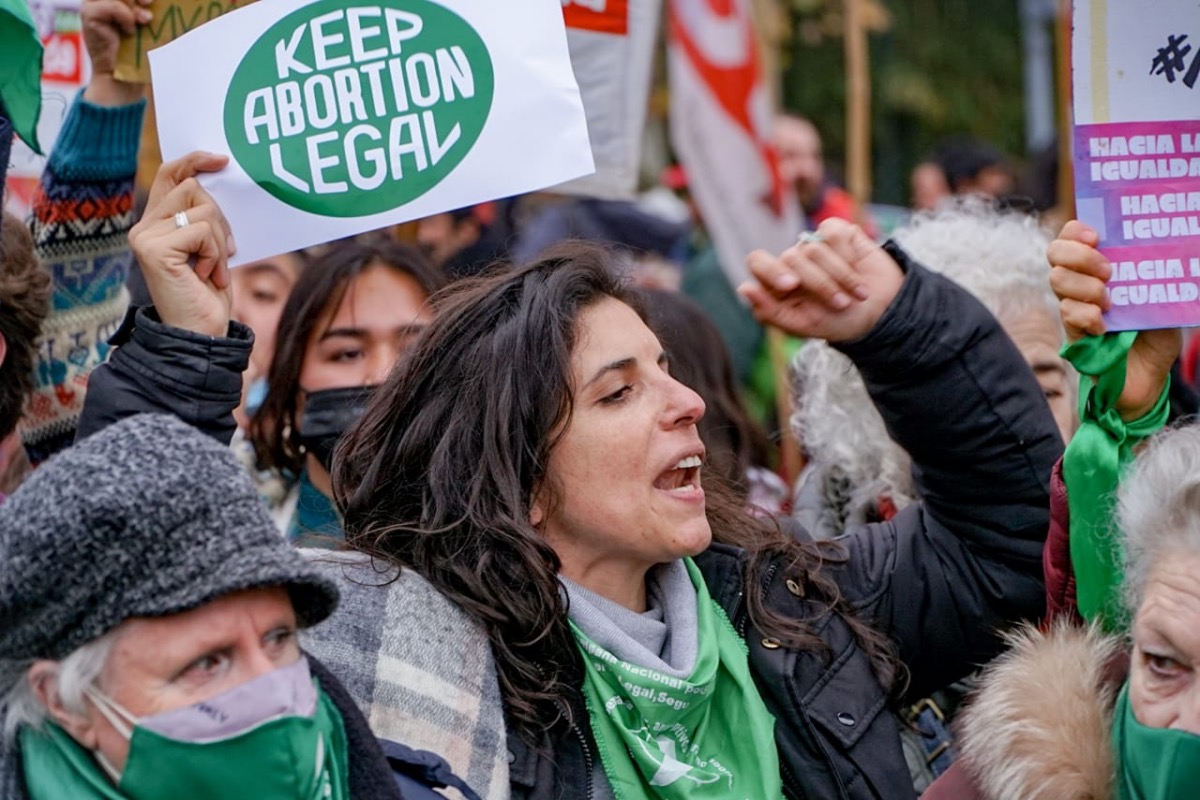

Cele Fierro, a leader of Argentina’s Socialist Workers’ Movement and the feminist group Juntas a la Izquierda, during a march on the U.S. embassy in Argentina to protest the U.S. Supreme Court overturning ‘Roe v. Wade,’ Buenos Aires, Argentina, June 27, 2022. (Courtesy of Cele Fierro)
On Monday, June 27, in a stunning display of international solidarity, dozens of reproductive justice advocates marched on the U.S. embassy in Argentina to condemn the Supreme Court’s ruling in Dobbs v. Jackson Women’s Health Organization, which overturned the landmark 1973 decision in Roe v. Wade establishing federal protections for abortion rights.
The National Campaign for the Right to Abortion and various civil society organizations, including the Socialist Workers Movement, organized the protest march.
“The protesters chanted ‘Legal abortion, worldwide!’ and ‘My body, my choice!’ as they stood in defiance in front of the embassy,” Left Voice reported. Some held signs in English to further show their solidarity with abortion rights advocates fighting for safe and legal abortion in the United States.
#KeepAbortionLegal #MyBodyMyRights #mybodymychoice @left_voice @izquierdadiario @PanyRosas_Arg ? @enfoquerojoph pic.twitter.com/bIoy90LJbR
— Andrea D'Atri ?✊? (@andreadatri) June 27, 2022
“In this capitalist and patriarchal system all our rights are at risk. That is why, here or there, we go out to the streets to defend them,” Cele Fierro, a leader of Argentina’s Socialist Workers’ Movement and the feminist group Juntas a la Izquierda (Together on the Left), tweeted in Spanish.
#EEUU Una ola verde mundial ??
En este sistema capitalista y patriarcal todos nuestros derechos están en riesgo. Por eso, acá o allá, salimos a la calle para defenderlos ? pic.twitter.com/whMIglH4nH
— Cele Fierro (@Cele_Fierro) June 27, 2022
On the evening of June 30, a smaller group of protesters marched on the residence of U.S. Ambassador Marc R. Stanley to repudiate the Court’s ruling. Some dressed like characters from The Handmaid’s Tale, the hit Hulu series adapted from Margaret Atwood’s best-selling novel about a dystopian society that forces women into sexual servitude in a last-ditch effort to repopulate a world ravaged by the climate crisis.
They stood in close proximity to one another. Practically motionless and completely silent, protesters held green bandanas as the lights from a nearby police car flickered against their partially-covered faces.
‘Elections Are Not Enough’
In the United States, thousands of reproductive justice protesters have mobilized in cities nationwide to voice their opposition to abortion restrictions. They’ve taken to the streets en masse with hundreds rallying outside the Supreme Court Building and countless others staging demonstrations across the country and around the world.
Many of them, including Rep. Alexandria Ocasio-Cortez (D-NY), wore green —a symbol of the global struggle for abortion access— adorning themselves with bandanas and kerchiefs of the same color.
“Elections are not enough,” Ocasio-Cortez said before the crowd outside the Supreme Court Building on June 24, the day the Court’s decision was announced. “We need to show up at the ballot box, yeah, but that’s the bare minimum.”
The Global Green Wave
Millions of reproductive justice advocates have been riding the global “Green Wave,” a socialist and feminist-led movement that began in Argentina during the early 2000s. Internationalism is at the core of the movement, which has since blossomed into a borderless, boots-on-the-ground battle for bodily autonomy and women’s rights.
“It is the same struggle that women and dissidents around the world are waging for our rights to be recognized,” Fierro told Latino Rebels. “It is the same struggle that we have been fighting in Argentina for decades—for the right to legal, safe, and free abortion.”
Abortion is legal in some Latin American countries. Abortion in Cuba, always an outlier in the region, was decriminalized in 1965, while Uruguay legalized abortion in 2012 for the first 14 weeks of gestation. In 2020, Argentina also legalized abortion for the first 14 weeks.
Mexico’s Supreme Court decriminalized abortion in 2021. The procedure is legal in eight Mexican states for up to 12 weeks into a pregnancy “and longer in cases of rape or to save a patient’s life,” KBPS reported.
These victories came after years of mass mobilizations by abortion rights advocates across Latin America. Countries like the Dominican Republic, Chile, Brazil, and Honduras have had their fair share of reproductive justice demonstrations as well.
“We are proud and excited to see that, in the United States itself, the comrades raise the green scarf as a symbol of the struggle for reproductive rights and for legal abortion,” Fierro said, adding that the kerchief is a symbol inspired by the Grandmothers and Mothers of Plaza de Mayo who rose up against the military dictatorship in Argentina during the 1970s.
‘It’s the Same Struggle’
As the Green Wave movement expands in the United States, abortion rights activists —filled with a fervor nearly proportional to that of the Black Lives Matter protests in the summer of 2020— find themselves at the forefront of this global struggle.
“International solidarity is really important for [us] in the U.S. because we can learn so much from the Green Wave movement,” Lupe M. Rodriguez, executive director of the National Latina Center for Reproductive Justice, told Latino Rebels. “We have a very important opportunity to galvanize the kind of support that we’ve learned from our counterparts in Latin America is possible to engender change.”
Pro-choice protesters and politicians alike have emphasized the centrality of direct action in the movement. By building on the power of state and local leaders, advocates hope to mobilize large swaths of the country like never before.
Past efforts to codify Roe at the federal level have faltered, and now, under the crushing weight of the Court’s ruling in Dobbs, national organizations are forced to pivot toward bolstering local abortion funds that help cover the cost of procedures as well as abortion-related expenditures like travel and childcare.
“Abortion funds often serve as an initial point of contact and primary support system for patients navigating myriad barriers… And they play a crucial advocacy role in addressing those most impacted by these restrictive laws,” according to a report published by the Brennan Center for Justice.
National abortion funds aren’t strapped for cash. In fact, they’ve been flooded with funding.
According to the New York Times, the National Network of Abortion Funds has received over $4 million since Politico first reported on a leaked draft of the looming Supreme Court decision. Abortion rights groups and even some Democratic fundraising platforms saw a surge in donations after the leak, NPR reported.
But with the overturning of Roe, the demand for abortion-related financial assistance is expected to increase significantly. Establishing interstate abortion travel networks and ramping up clinical capacity in sanctuary states will also come at a hefty cost. Moreover, anti-abortion lawmakers have been working to impose legal restrictions on these developing networks that “aid and abet” women in their time of need.
Undergirding such challenges are systemic inequities in the American healthcare system as well as a litany of medical, psychological, and financial issues for women who experience forced birth.
“Our communities have faced structural barriers that have placed us at a significant disadvantage for a very long time,” Rodriguez said. “Now, with the repeal of these protections for abortion… these existing inequities… will make it impossible for many people to get abortion care.”
Women of color have been hit especially hard by the Supreme Court’s decision, as maternal mortality and morbidity have disproportionately impacted Black and Indigenous women.
Maternal mortality and morbidity rates, among the litany of deleterious public health outcomes now exacerbated by #SCOTUS overturning #RoeVWade, will disproportionately affect Black and Native American/Alaska Native women.
Via @NBCNewsGraphics pic.twitter.com/uqoLkh8kOb
— James Baratta (@jamesjbaratta) July 5, 2022
“When you restrict access to contraception and safe, legal abortions… it’s going to contribute to more deaths and morbidities,” Dr. Amy Raines-Milenkov, associate professor at the University of North Texas Health Science Center at Fort Worth and director of UNT’s Healthy Start program, told Latino Rebels.
“What we have seen is an increase in Hispanic maternal mortality,” she said.
Rodriguez explained that, along with Black and Indigenous people, immigrant women are also at an elevated risk for maternal mortality and morbidity.
“Many of our immigrant community members [are facing] not only existing barriers [like] not having insurance coverage or access to healthcare,” she said, “but also there’s very practical barriers for them to be able to move around to get the care that they need.”
NBC Latino reported that states that have trigger laws —meant to institute abortion restrictions once Roe was overturned— are more likely to have higher rates of uninsured women living below the poverty line, and 33 percent of Latinos in states with trigger bans lack health insurance.
@NBCLatino reports that states that have enacted trigger bans are more likely to have higher rates of uninsured women living below the poverty line.
“On average, 33% of #Latinos in trigger law states are uninsured, compared with 21%… in states with legal #abortion.” pic.twitter.com/FsXVUQNrto
— James Baratta (@jamesjbaratta) July 5, 2022
“The reversal of Roe v. Wade is really detrimental to women, and if we’re trying to reduce maternal mortality… this is step back—a big step back,” Raines-Milenkov said.
There is widespread support for abortion access among Latinos and throughout the United States. Approximately 50 percent of Latina voters believe abortion should be legal in all cases, and 80 percent think pregnant women should be able to terminate a pregnancy without fear of prosecution, according to a joint survey conducted by the National Latina Institute for Reproductive Justice.
Fierro, who marched on the U.S. embassy in Argentina with dozens of her comrades in June, told Latino Rebels that abortion rights advocates must show up whenever the right to choose is under threat.
“To fight for reproductive rights… is to understand them as a public health problem, to understand it as a human and social right —of class— because it is also a question of inequality,” she said. “Abortions are not going to stop being practiced. Those who can afford it will do so, and those who cannot will access unsafe practices and put even their own lives at risk.”
Both Fierro and Rodriguez agree that the solution to maintaining the Green Wave’s momentum lies in direct action, mass mobilization, and international solidarity.
“A lot of the successful outcomes that came out of the movement were tied to deep investment in people and not an undue focus on legislation necessarily at the outset or litigating ourselves out of problems,” Rodriguez explained. “And in the U.S., we haven’t really engaged a lot in that kind of work in order to be able to engender change.
“I think this is the moment for us to do that,” she said.
***
James Baratta is a freelance journalist graduating from Ithaca College in May 2022 with a B.A. in journalism. He has written for Common Dreams, Fairness & Accuracy In Reporting, and Truthout, among others. Twitter: @jamesjbaratta



[…] Source link […]